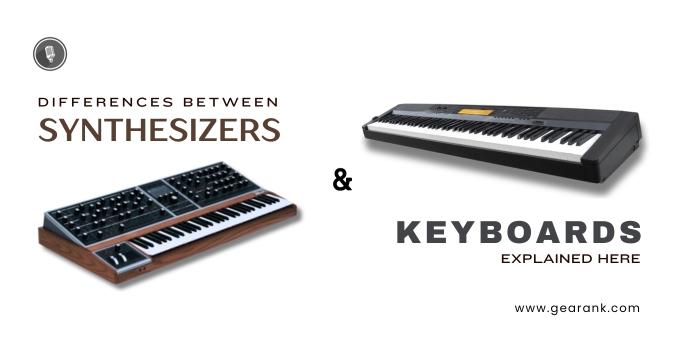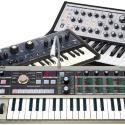Synthesizer vs Keyboard: Look here for the Difference

Synthesizer vs keyboard: the terms surrounding them do bury their meanings quite a bit. After all, both also look very similar, have sound banks, and both play the same way.
With all the slew of developments that have happened in music technology, many of them have overlapping features. Some come with dedicated piano sounds, some are focused on synth sounds, while others have both.
But with a keen eye and the right information, you'll be able to differentiate them easily. In this guide, I'll walk you through the difference between a synthesizer vs keyboard. We will also briefly go through their variations so you can find the right one for you.
What Is A Synthesizer?
A synthesizer is a type of electronic instrument dedicated to generating and modifying audio signals. The purpose of a synthesizer is to allow the sound designer or the performer to combine basic wave shapes so they can make their custom-made sounds. At its core a synthesizer has 3 parts in its signal chain.
-
Oscillators
-
Filters
-
Envelopes
Hardware synthesizers create sound through an oscillator. Synthesizers usually have 2-3 oscillators for designing your own sound. Earlier models of synthesizers are capable of using 4 basic waveforms: sine, square, sawtooth, and triangle. These synth sounds are the very first foundations that make synthesizers what they are today.
A synthesizer also has assignable knobs or faders called filters. What it does is it allows you to cut the high and low frequencies of the waveform. This enables you to shape the timbre or tone further.
If the synthetic sounds of an oscillator can be shaped by a filter, envelopes modify their sound over time. Here, you have attack, decay, sustain, and release.
-
The attack is responsible for how suddenly or how slowly the sound reaches its peak volume.
-
Whereas the decay knob or fader is the time it takes to reach the sound's sustain.
-
The sustain is the overall level of the sound when the key is still pressed.
-
The release is the duration of time before the sound reaches level 0 the moment you let go of the keys.
Some units have built-in effects for extra sound synthesis options, including delay, reverb, compressor, and distortion.
Types of Synthesizers
There are 3 common types of synthesizers that you can find on the market. Most of them work similarly with slight variations.
Analog Synths make sounds through fluctuating electrical signals / voltage. They're the classic synths that have a plethora of knobs, cables, and settings. Analog synthesizers have parameters that have to be adjusted manually to change the sound. Their settings have to be written down because they don't have a "save" function. Analog synths come in either sound module form (without keys), or with built-in keyboards attached to the sound modules.
Nowadays, they are considered a luxury because of their high price and because they contain the classic synth sounds of the past.
Digital synthesizers were first introduced in the 70s. With these electronic instruments, sound creation happens with a special chip called a DSP or digital signal processor. that generates sounds that typically would be impossible to create with an analog synth.
From frequency modulation to midi controllers, digital keyboard synths give you much more freedom and options to shape your sound.
Virtual Analog Synths combine the technological benefits of a digital synthesizer with the classic sound of an analog synth. Virtual synths simulate the sound characteristics of an analog synth through an algorithm. It still uses DSP as its main engine but is done in a way that closely mimics the physical nuances of an analog synth. These are cost-effective solutions for adding synth sounds to your own music.
What Is A Keyboard?
A keyboard is a musical instrument intended to be the portable version of a real acoustic piano. Aside from the sound of a digital piano, its collection of sounds is based on real instruments.
Regular keyboards don't produce sound the way a synth does. The sound options you hear on a keyboard are most likely sample-based. This means that the piano, trumpet, or string sounds you hear on a keyboard are recorded and stored in its sound engine.
This being said, most keyboards are based on the piano, and you can see why: they have the usual black and white keys. They can also vary from digital pianos to acoustic pianos.
Types of Keyboards
Arranger Keyboards are specifically built for live performers and musicians. They come with a ton of realistic sounds sampled from different instruments. But the Arranger keyboards' strongest suit would be its ability to play auto accompaniment. This feature allows you to select which genre or beat. Whatever chords are engaged can be played one time, and the keyboard will automatically play it for you until you switch to another chord. You can also recall your songs with just a few button presses.
Workstation Keyboards is an all-in-one solution marketed towards music producers and composers who want to make music in the box. It showcases the ability to multi-track for different digital musical instruments, samplers, and synthesizers. This electronic keyboard can be considered a hybrid of an arranger keyboard and a synthesizer. This gives you the option to step away from your DAW and just solely focus on the music making. The best keyboard workstation options are, of course, pricier than usual.
Synthesizer vs Keyboard: Key Differences
There are some clear differences between a synthesizer and a keyboard. Here are all the key differences between a synth and a keyboard.
Who Uses Synthesizers And Keyboards?
Keyboards and digital grand pianos are the go-to instruments of beginners and performers alike. It's a practical alternative to a real piano and doesn't take up much space.
On the other hand, synthesizers are typically used by professional musicians and music producers who make electronic music. For sound designers, it's a tool to make unique sounds for film scores and games.
Notable Features
Knobs and Faders
If you take a look at the design of a synthesizer, you can already tell that it has more knobs and faders than keyboards and stage pianos. The parameters of a synthesizer give way to more sound exploration because you can dial in the settings to get the specific sound you're going for.
Keyboards and digital grand pianos are built for simplicity. Its sound bank works right off the bat, and there's no need to edit the sound.
Sound Production
Synthesizers use oscillators, and the sound they produce is electronic-based. These are called creative synths because you have the ability to synthesize your own sounds. Most of the cheaper synths are called imitator synths, as they just produce the sound of sampled synthesizer instruments, instead of actually synthesizing the sound.
Note that they have to be connected to an external speaker system, amplifier, or headphones to get the sound out.
Conversely, a keyboard's sound bank involves samples from real instruments, including acoustic pianos, electric piano sounds, synth sounds, and many more. Portable keyboards come with built-in speakers, making them an all-in-one
Key Action
While the key action will vary from brand to brand, most keyboards and synthesizers have synth action or are semi-weighted. They're light to the touch and are capable of varying velocities depending on key pressure.
Premium keyboards, however, can come with weighted keys that closely mimic the weight of a real piano.
Ease of Use
With a keyboard, any beginner piano player can turn on a keyboard and start playing right away. Digital keyboards have automated accompaniments that can make the process of learning piano much more entertaining.
Most digital pianos and keyboards include their built-in speakers which means that you don't need any extra equipment to play digital pianos.
Synthesizers have more complex settings and require an in-depth knowledge of how synthesizers work. However, it becomes easy to use once you know its basic settings.
That being said, some overlaps in their feature can also happen between different brands.
Final Thoughts
Now that you know the difference between a synthesizer vs keyboard, it would be easier to know which one fits your criteria.
If you're seeking to design soundscapes that echo, a synthesizer is an indispensable addition to your music production. On the other hand, if you're an beginner who wants to learn piano or a performer who wants a good sounding electric piano, horns, and strings, then a keyboard is an all-in-one solution for your gigs.
Frequently Asked Questions
Can You Use A Synthesizer As A MIDI controller?
Except for older, vintage synthesizers, most synths in the market can be used standalone and as a MIDI keyboard. All you need is a MIDI interface or a USB chord that connects both the synth and the computer.
Is It Best To Learn Keyboard Before Synth?
It's better to learn the fundamentals of playing the piano before synth. It will develop your finger dexterity, and with the knowledge of music also comes more musical ideas. You can also learn to play piano and learn synthesis works at the same time. This way, you can produce your own sounds and develop versatility in any music style imaginable.
Contributors:
- Allen Articulo - Co-writer
- Jerry Borillo - Illustrator












